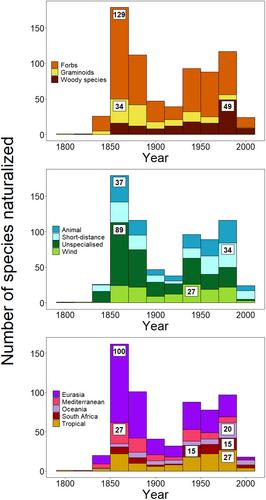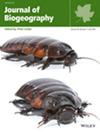Investigating the extent of insular invasions by non-native species (i.e., the number of islands they occupy) is central to island conservation. However, interrelationships among plant life history traits, naturalization histories, and island characteristics in determining island occupancy by non-native plant species are poorly understood. We investigated whether island occupancy by different non-native plant species declines in relation to their year of first naturalization and whether periods of first naturalization differ among growth forms, dispersal modes, and biogeographic origins. Then, we asked if non-native plants that naturalized more recently occur more frequently on islands that are large, less isolated, and close to urban areas. We contrasted trends across growth forms, dispersal modes, and biogeographic origins.
264 offshore islands in northern Aotearoa New Zealand.
Vascular plant species.
We combined field surveys and published data for 767 non-native plant species on the islands. We categorized each species according to its growth form (n = 3), dispersal mode (n = 4) and biogeographic origin (n = 5) and identified its year of first naturalization in Aotearoa New Zealand. We tested our hypotheses using ANCOVA and generalized linear models (GLMs).
There were similar declines in island occupancy in relation to the year of first naturalization in Aotearoa New Zealand across all trait and biogeographic origin categories. First naturalization times of herbaceous species, those with unspecialized dispersal modes, and those originating from Eurasia and the Mediterranean basin were disproportionately earlier than other categories. Non-native plants with more recent first naturalization occur more frequently on large islands close to urban areas, but not on less isolated ones. Relationships with island characteristics did not differ among trait and biogeographic origin categories.
Overall, time of first naturalization was more important than trait and biogeographic origin categories in explaining non-native plant invasion patterns on islands. Since there were similar relationships between island occupancy and the year of first naturalization in Aotearoa New Zealand for all categories, management bodies should focus on non-native plant species of trait and biogeographic origin categories that have naturalized recently (e.g., woody species from other regions within Oceania), and on large islands close to urban areas. Introduction and naturalization histories provide essential context for interpreting the role of plant traits and biogeographic origin in understanding plant invasions on islands.



